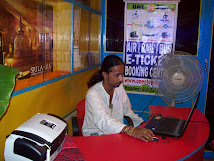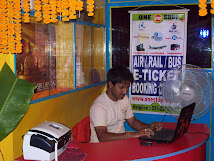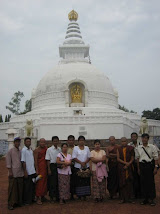Today india news paper India sadhu drive jeep car to Ganga Saga celebration. I would like to share my blog reader.One of interesting celebration in inida.
The ganges river is known as Mother Ganga.
Ganga sagar is the end of mother ganga 2700 Km. course where she
meets the bay of bengal.
Population: 75 million
Capital: Calcutta
Area: 88,000 sq km
Best Time to Visit: October to March
Main Language: Bengali
Literacy Rate: 59%
Initially, river Ganga flowed in the heavens. She was brought down to earth by the severe penances of the sage Bhagiratha and that is why she is also called Bhagirathi. According to the story, of the descent of the Ganga, once a number of demons were harassing the hermits by disturbing them in their ascetic duties. During the day, they would be chased into the ocean. But in the darkness of the night, they would emerge from the ocean and start harassing the hermits again. In desperation the hermits appealed to Rishi Agastya. Agastya, known for his gastronomic powers, drank all the water of the ocean. Though this was done in good faith, it resulted in depriving the world of the water needed for sustenance and the earth became parched and dry. Bhagiratha brought this drought to and end.
Gangapujan Dashahara or Dussehra
This is literally the "birthday or descent of mother Ganges - Ganga Ma". Throughout india this festival lasts ten days beginning on the Amavasya (dark moon night) and going through to the dasami tithi (tenth phase of the Moon, the day before Pandava Nirjal Ekadasi)
"Festivals connected with rivers are essentially bathing festivals. Ganga Dussehra is celebrated on the tenth day of Jyeshtha. River Ganga is worshipped as a mother as well as a Goddess, particularly by people of Uttara Pradesh, Bihar, and Bengal through which the river flows. On this day, if a devotee is unable to visit and bathe in the river Ganga, then Ganga jal (water) kept in most Hindu homes is used for purification. A bath in the river is said to purify the bather of all sins. The Ganga is revered all over India even in places far from its course
According to the Agni Purana and Padma Purana, the Ganga descended to the earth on Ganga Dussehra day and a bath in the holy river on this day is said to purify one of all sins. To die on the banks of the Ganga is considered most auspicious. If that is not possible, then the immersion of the ashes after cremation in the river Ganga is a must, as it then releases one from the cycles of birth and re-birth.
the seven ways of worshipping the Ganga are: by calling out her name, 'Oh Ganga'; having darshan of her; by toughing her waters; by worshipping and bathing; by standing in the waters of the river; and by carrying clay dug out of the river. Ganga in her anthropomorphic form is shown as a beautiful young woman standing on a crocodile and holding a waterpot in her hands. Her image, with that of the Goddess Yamuna, another sacred river deity, is often depicted on the doors of temples and palaces. In Gujarat, there is a legend according to which Ganga came down to the earth on Rishi Panchami, the fifth day of Bhadra (September) at Tarnetar

The river Ganga which originates in the Gangotri glacier in the snow clad Himalayas, descends down the mountains, reaches the plains at Haridwar, flows through ancient pilgrimage sites such as Benares and Prayag, and drains into the Bay of Bengal. Sagar Island, at the mouth of the river Hooghly in Bengal (accessed from Diamond Harbor), where the Ganga breaks up into hundreds of streams, and drains into the sea, is honored as a pilgrimage site, signifying the spot where the ashes of the ancestors of Bhagiratha were purified by the waters of the Ganga.
The Kapila muni temple at this site is a center of worship. The origins of this temple are obscured in antiquity - the current structure being a recent one, housing a stone block considered to be a representation of Kapila Muni; there are are also images of Bhagiratha, Rama and Sita.
A dip in the ocean, where the Ganga drains into the sea is considered to be of great religious significance particularly on the Makara Sankranti day when the sun makes a transition to Capricorn from Saggitarius and this town becomes home to vast fairs, drawing visitors and recluses (sanyasis) from all over the state
Ganga Sagar Mela A Dip for Moksha
The village priest leading his horde of devotees chants sab teerth baar baar, Ganga Sagar ek bar. You can go to all the holy places, but a pilgrimage to Ganga Sagar equals them all. A dip means redemption for all wrong done. This place is Sagar Island, on the confluence of the Ganga with the Bay of Bengal. The day “Makar Sankranti” or the last day of the month of Paus (December).
Legend has it that, before joining the sea, the Ganga watered the mortal remains of King Sagar’s 60000 sons liberating their souls once and forever. It was standing on the Sagar Island that the mythical Kapil Muni condoned th sins of the sons of King Sagar who had dared to stop the horse blessed at Lord Indra’s Aswamedha Yagna and tied it to a post near his temple. It is this legend that attracts people to this little island in a remote southern corner of West Bengal.
The Ganga Sagar mela (fair) is the largest annual assemblage of devotees in India. The greatness of the mela can be assessed from the fact that over a million pilgrims come from far-flung corners of India and beyond, speaking different languages and belonging to diverse castes and creeds, for a sacred dip at this holy confluence. For this, no invitation is given. No propaganda is carried out and overall no authority exists for carrying out the mela.
It is indeed a tough journey. A few days in packed buses and trains bring the pilgrims to Calcutta. From there, again a long bus journey to ferry ghats or jetty in Sunderbans area, followed by crossing the tidal river stretching for miles across. The last leg involves either walking or traveling by a local bus upto 30 kilometres depending on the location of embarkation point.
The journey can be tiring but religious fervour of the pilgrims overcomes all hardships. Kapil Muni ki jai, Kapil Muni ki jai, (Hail Kapil Muni), the din rises above the grinding motors of the launches ferrying the pilgrims across the Ganga and the countless buses plying between Calcutta and Namkhana. The problem of traveling doesn’t deter even the weak and vulnerable. Old people in their eighties, and village women carrying babies and little children in tow are a common sight.
The never ending stream of pilgrims keeps pouring in throughout the day and night before the auspicious day and occupies any available space on the sandy beach. They move about the place in groups, many displaying saffron and red flags, identifying the religious Akhara (group) they belong to as well as acting as beacon to the members who stray out of the group.
People walks to the sound of the bells, blowing conch shells and chanting prayers. Strains of devotional songs can be heard from far and near. And, the ceaseless din of loudspeakers. An array of shops, stacked with heaps of vermilion, rudraksha, colourful beads, conch shells line the pathways. Many a visitor stands wide-eyed before the shops selling everything from food stuff, household utensils to remote controlled toys.
People crowd around the naga sadhus (naked ascetics) without whom the Ganga Sagar mela is incomplete. Sitting naked in little huts near the temple and enjoying a chillum of ganja, (cannabis) they are also the target of tourists’ camera.
While devotees jostle in front of numerous temporary shrines of Hindu deities to pay homage, Kapil Muni’s temple remains the chief attraction. The temple of Kapil Muni, as we see it today, is by no means the spot where the sage meditated. It went under the sea millennium ago followed by the many others built in its place, which subsequently was also swallowed, by the advancing sea.
The present one was built only a few decades ago, quite a bit away from the sea. The tall dome of the temple is visible from a distance. In the temple, three images engraved in stone are displayed, the one in the middle is that of Kapil Muni. The sage is seen in a jogasana; his eyes wide open, looking towards the sea with millions of devotees before him. The idols of Ganga and King Sagar flank Kapil Muni and the horse of the sacrificial yagna stands at a distance.
The typical Ganga Sagar pilgrim is a country rustic, generally elderly, hardy, remarkably disciplined and fervent in his devotion. His dhoti seldom going below his knees, a cloth bound packet, containing everything needed for survival, on his head. And, of course, his women – heavily tattooed and clad in colourful saris.
As the night, pregnant with the auspicious moment, descends, all wait for the precise hour to take the dip. The sandy track to the water’s edge is crowded with people who sit around fires before proceeding for the bath, chanting devotional songs and prayers. The seaside presents a spectacle in the darkness before dawn with the large bonfire lit by the bathers to keep off the cold.
At midnight, the high tide drives the pilgrims back. The biting cold wind of mid – January from across the sea lashes the bare body. But there is a confidence on their faces and a kind of fire in their eyes. The confidence in God and the fire of earnest faith makes them brave the chill.
The stars in the sky have quite a long time to fade when the moment of truth comes. As soon as the priest announces, the auspicious pre-dawn hour, the crowds surge forward to meet the tide with a loud chorus Kapil Muni ki jai and plunge into the sea. Suddenly the place is charged with the extraordinary power of the believers.
After taking their holy dips, the shivering devotees trudge the one kilometre expanse leading to the brightly lit temple of Kapil Muni, where prayers were performed. Coconuts, flowers, vermilion, sweets, and money are offered to the image of the ancient sage.
The bustle of activity continues for quite sometime in the morning as the pilgrims perform a series of rituals including the symbolic godan to Brahmins. A calf is symbolically handed over to the Brahmin priest by the devotee. Many perform the symbolic crossing of the river of blood, baitarani to attain moksha or transcendation. It is interesting to observe the people, clutching the tail of a cow and wading through a puddle a few paces. Many people shave their heads and perform the last rites of departed relatives.
A number of marriages are solemnized on the beach during the day. Also, many local girls get married to the sea. This will ensure that theoretically they never become widows, even if their menfolk, braving the rough sea and tiger infested jungle for a living, die.
It is no wonder that for many tourists from abroad, like though French couple I met, Sagar mela is something more than a mammoth religious congregation. They have visited the mela twice and found “something which has disappeared from France and Europe at least half a century ago”.
Naturally this large an affair leads to some confusion. People get lost. The public address system works overtime as relatives try to trace those they have lost.
But the majority of the pilgrims take it easy. After the rituals are complete, they dry their clothes and hair, cook their food on open fires, eat and rest. Happy, contented and smiling, having made the pilgrimage.
The Ganga Sagar mela continues to throb with life, with the energy of millions of pilgrims. The pilgrimage may be extremely tough, but the pilgrims know that the visit will purify their souls. The visit fulfils their lifelong desire and often one can see tears of joy rolling down their cheeks. That is the magic of religion
http://www.liveindia.com/ganga/gangasagar.html

















